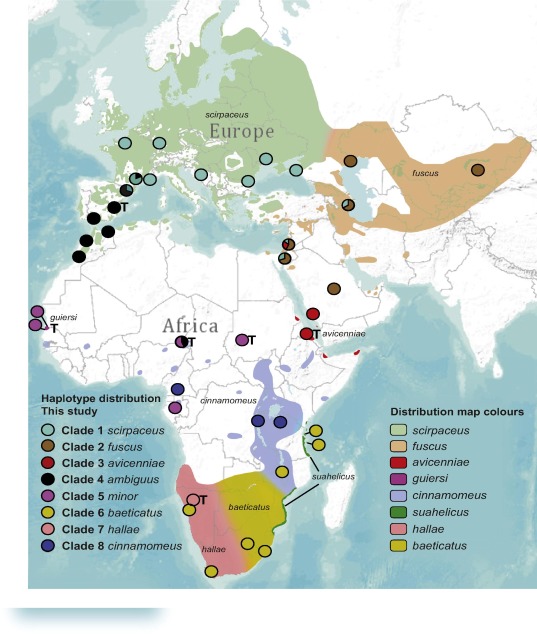Two new taxa of ‘reed warbler’ in North Africa and the Iberian Peninsula
Two studies published in 2016 ‘added’ two taxa of the Eurasian/African Reed Warbler complex to the avifauna of North Africa and the Iberian Peninsula. The first taxon from Morocco and Spain is either a subspecies – of the Eurasian or the African reed warbler – or a full species (so, three options). The second taxon is a new subspecies described from the Libya/Egypt border.
African Reed Warbler north of the Sahara, or another full species?
The first study by Olsson et al. (2016) analysed the phylogeny of the Eurasian/African reed warbler complex (Acrocephalus scirpaceus – A. baeticatus) and found eight distinct lineages or clades well-structured geographically. Seven of these eight clades correspond to taxa in current use (namely: scirpaceus, fuscus, avicenniae, minor, cinnamomeus, hallae and baeticatus).
The clade which does not have any name currently in use is formed by the reed warblers breeding in Northwest Africa and the Iberian Peninsula south of Catalonia. The analysis however showed that this clade included the taxon “Calamoherpe ambigua” described more than 150 years ago by Brehm (1857), but the name has never gained widespread use. So the authors proposed the resurrection of the name ambigua in the form ambiguus, to agree grammatically with the gender of Acrocephalus. The birds forming this clade are small and intermediate between scirpaceus and baeticatus in morphology but similar to scirpaceus in plumage.
Taxonomic implications
In the taxonomic implications of the study, the authors proposed four main alternatives:
- The most conservative approach is to treat all the eight taxa as subspecies of Acrocephalus scirpaceus.
- The second approach is to recognise two species: Eurasian Reed Warbler with 3 subspecies (scirpaceus, fuscus and avicenniae) and African Reed Warbler with 5 subspecies (baeticatus, cinnamomeus, hallae, minor and ambiguus).
- The third approach is to recognise three species: Acrocephalus scirpaceus (3 subspecies as above), Acrocephalus baeticatus (3 subspecies: baeticatus, cinnamomeus and hallae) and Acrocephalus ambiguus (2 subspecies: ambiguus and minor).
- And finally, the most radical alternative approach would be to treat all eight lineages as full species.
Implications for birding
I believe that the most likely approach to be followed is to split this species-complex into either two or three species (the options 2 and 3 above). In birding language, this means the birds breeding in Northwest Africa and the Iberian Peninsula would be called either:
- Acrocephalus baeticatus ambiguus (African Reed Warbler – Rousserolle africaine), or
- Acrocephalus ambiguus. The English name ‘Moroccan Reed Warbler‘ (Rousserolle marocaine) was proposed back in 2010. What about translating the scientific name as ‘Ambiguous Reed Warbler‘ (Rousserolle ambigue)?
Read the paper (PDF):
Olsson, U., Rguibi-Idrissi, H., Copete, J. L., Arroyo Matos, J. L., Provost, P., Amezian, M., Alström, P. & Jiguet, F. 2016. Mitochondrial phylogeny of the Eurasian/African reed warbler complex (Acrocephalus, Aves). Disagreement between morphological and molecular evidence and cryptic divergence: A case for resurrecting Calamoherpe ambigua Brehm 1857. Molecular Phylogenetics and Evolution 102: 30–44. doi: 10.1016/j.ympev.2016.05.026
Update:
Based on this study, the ‘IOC World Bird List’ (starting from version 6.4) adopted the second option cited above and included ambiguus in the African Reed Warbler. They also resurrected the subspecies minor and deleted the subspecies ‘guiersi’.


Siwa Reed Warbler: a new subspecies described from the Libya/Egypt border
The second study by Hering et al. (2016) deals with the description of a new subspecies of reed warbler: Acrocephalus scirpaceus ammon. The described taxon breeds in the oases of the large Libyan Desert depressions on the Libya/Egypt border (Qatara, Siwa, Sitra in the latter and Al Jaghbub in Libya).
The epithet ammon derives from the ancient Egyptian sun god Ammon-Re (or Amun-Re) who was deified by the local people of the Siwa Oasis and its environs. Siwa was known by the names Ammonion and Ammonium during ancient times.
Summury of the study:
A new subspecies of European Reed Warbler Acrocephalus scirpaceus is described from the Egypt / Libya border region in the northern Sahara. Intensive studies revealed the new form to be clearly diagnosable within the Eurasian / African Reed Warbler superspecies, especially in biometrics, habitat, breeding biology and behaviour. The range of this sedentary form lies entirely below sea level, in the large depressions of the eastern Libyan Desert, in Qatara, Siwa, Sitra and Al Jaghbub. The most important field characters are the short wings and tarsi, which are significantly different from closely related A. s. scirpaceus, A. s. fuscus and A. s. avicenniae, less so from A. baeticatus cinnamomeus, which is more clearly separated by behaviour / nest sites and toe length. Molecular genetic analyses determined that uncorrected distances to A. s. scirpaceus are 1.0–1.3%, to avicenniae 1.1–1.5% and to fuscus 0.3–1.2%. The song is similar to that of other Eurasian Reed Warbler taxa as well as that of African Reed Warbler A. baeticatus, but the succession of individual elements appears slower than in A. s. scirpaceus and therefore shows more resemblance to A. s. avicenniae. Among the new subspecies’ unique traits are that its preferred breeding habitat in the Siwa Oasis complex, besides stands of reed, is date palms and olive trees. A breeding density of 107 territories per 10 ha was recorded in the cultivated area. Nest sites in trees, palms and shrubs are unique in the Eurasian and African Reed Warbler superspecies. Foraging in oasis gardens is mostly in the tree canopy. There are clear parallels in foraging behaviour and ecomorphology to oceanic island reed warblers. Finally, the biogeographic situation in North Africa, the newly revealed high ecological plasticity of scirpaceus taxa, the substantial spatial separation from other reed warbler taxa, and the reasons why these warblers remained undiscovered for so long are discussed.
Hering, J., Winkler, H. & Steinheimer, F. D. 2016. A new subspecies of Eurasian Reed Warbler Acrocephalus scirpaceus in Egypt. Bull. Brit. Ornithol. Cl. 136: 101-128.